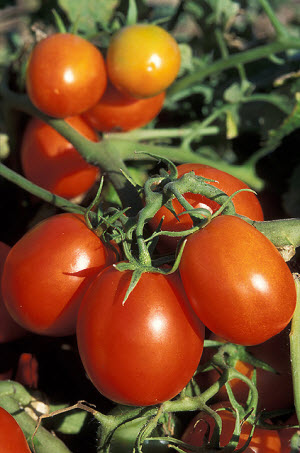 Roma (or plum) tomatoes are known for their durability in sauces and canning. ARS scientists at the Western Regional Research Center in Albany, California, have developed an infrared peeling technique that is mostly waterless to remove the peels from these tomatoes before canning.Peggy GrebThe researchers have demonstrated, for example, that infrared-based peeling is mostly waterless. That’s a benefit for canneries in sometimes-drought-stricken California, the state that produces the majority of the nation’s processing tomatoes.
Roma (or plum) tomatoes are known for their durability in sauces and canning. ARS scientists at the Western Regional Research Center in Albany, California, have developed an infrared peeling technique that is mostly waterless to remove the peels from these tomatoes before canning.Peggy GrebThe researchers have demonstrated, for example, that infrared-based peeling is mostly waterless. That’s a benefit for canneries in sometimes-drought-stricken California, the state that produces the majority of the nation’s processing tomatoes.
Not only could the technique cut the cost of bringing water to canneries, but it might also reduce the expense of recycling the water or properly disposing of it.
Disposal is of particular concern to processors who use sodium hydroxide or potassium hydroxide to peel tomatoes. These substances can increase the cost of treating factory wastewater, according to Pan.
What’s more, the infrared process may help reduce wasteful “overpeeling” of tomatoes that can occur when too many layers of tomato are inadvertently removed along with the peel. In a study published in the journal Innovative Food Science and Emerging Technologies in 2014, Pan and co-researchers showed that peel-related loss was about 8 to 13 percent with infrared heating as compared to about 13 to 16 percent with sodium hydroxide-based peeling.
The infrared studies are apparently the most extensive to date of their kind for environmentally sound peeling of tomatoes.
Pan, who is based at the Agricultural Research Service (ARS) Western Regional Research Center in Albany, California, and coworkers Tara McHugh, research leader and research food technologist at the Albany center, Carlos Masareje of Precision Canning Equipment, and James Valenti-Jordan of Del Monte Foods recently received a patent for the peeling process. Pan hopes to have the system ramped up to match cannery operating speeds by 2016.
This technology, highlighted in the January 2015 issue of Agricultural Research magazine, supports the USDA priority of reducing food waste. ARS is the USDA’s principal intramural scientific research agency.
The researchers have demonstrated, for example, that infrared-based peeling is mostly waterless. That’s a benefit for canneries in sometimes-drought-stricken California, the state that produces the majority of the nation’s processing tomatoes.
Not only could the technique cut the cost of bringing water to canneries, but it might also reduce the expense of recycling the water or properly disposing of it.
To continue reading this article, sign up for FREE to

Membership is FREE and provides you with instant access to eNewsletters, digital publications, article archives, and more.












